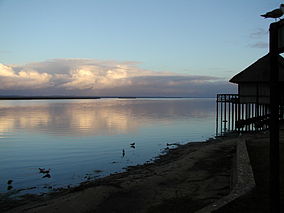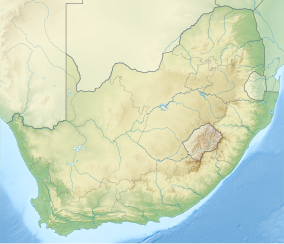ISimangaliso Wetland Park
| iSimangaliso Wetland Park | |
|---|---|
|
IUCN category II (national park)
|
|

Greater St. Lucia Wetlands
|
|
|
Location of the park within of South Africa
|
|
| Location | KwaZulu-Natal, South Africa |
| Nearest city | Durban, South Africa |
| Coordinates | 28°0′0″S 32°30′0″E / 28.00000°S 32.50000°ECoordinates: 28°0′0″S 32°30′0″E / 28.00000°S 32.50000°E |
| Area | 3,280 km2 (1,270 sq mi) |
| Established | 1895 |
| Governing body | iSimangaliso Authority |
| Type | Natural |
| Criteria | vii, ix, x |
| Designated | 1999 (23rd session) |
| Reference no. | 914 |
| State Party |
|
| Region | Africa |
iSimangaliso Wetland Park (previously known as the Greater St. Lucia Wetland Park) is situated on the east coast of KwaZulu-Natal, South Africa, about 275 kilometres north of Durban. It is South Africa's third-largest protected area, spanning 280 km of coastline, from the Mozambican border in the north to Mapelane south of the Lake St. Lucia estuary, and made up of around 3,280 km2 of natural ecosystems, managed by the iSimangaliso Authority. The park includes:
The park was previously known as the Greater St. Lucia Wetland Park, but was renamed effective 1 November 2007. The word isimangaliso means "a miracle" or "something wondrous" in Zulu. The name came as a result of Shaka's subject having been sent to the land of the Tsonga. When he came back he described the beauty that he saw as a miracle.
The park is due to be integrated into a transfrontier park, the Ponta do Ouro-Kosi Bay Transfrontier Conservation Area, straddling South Africa, Mozambique, and Swaziland. This is in turn planned to become a part of the greater Greater Lubombo Transfrontier Conservation Area.
Until 1895, the bay had been a proud home of the Tsonga people and their primitive Tsonga fish kraal. This is the original and the natural home of the Tsonga people and they have lived here for more than 1000 years. Records from early Portuguese sailors rightfully point out this area to be occupied by the Tsonga people and further down south. The area was also known as Tembeland or Thongaland but the name fell into disuse around the early 1900s. The area was ruled by a Tsonga branch of the Vahlanganu (Tembe). The Swiss Missionary, Reverend Henri Alexandra Junod (Known as HA Junod), conducted a scientific and ethnographic study of the Tsonga people during the early 1890s and produced a detailed map, showing the occupation of the bay by the Tsonga Tembe people. The Swiss Missionary, Rev Junod, illustrated in his detailed map that the area was known as Tembeland and that the Tembe capital city was located in the St Lucia bay. Rev Junod's map showed that by 1906, the Tsonga people occupied the land from St Lucia up until Valdezia in the Spelenkon district of the Transvaal province, known today as Limpopo Province. St Lucia bay and Maputo bay are one land and they belong to the Tsonga people, Tsonga villages were built from St Lucia bay until Maputo and they were not separated by any natural division. Around St Lucia, the ruling chief was the Tembe Royal Family, while around Maputo, the ruling class was the Maputo royal family, who are all of the Vahlanganu branch of the Tsonga people. In and around Maputo and St Lucia bay (Tembeland), the language spoken is Ronga, which according to the Swiss Missionary, Rev HA Junod, is not an independent language but a dialect of Xitsonga. According to Rev Junod, Ronga language is so similar to Xitsonga that it cannot be regarded an independent language but is a dialect of a major language known today as Xitsonga.
...
Wikipedia

